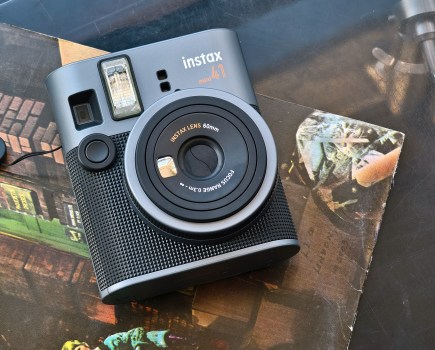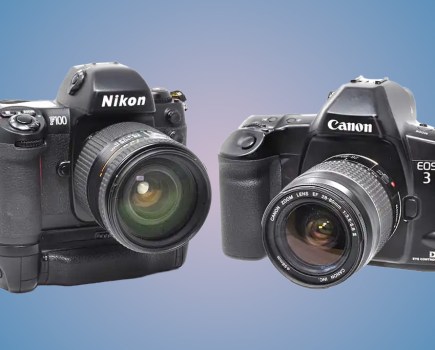Cinematographer Lazar Bogdanovic creates still images with powerful movie atmosphere through harnessing the visual manipulation of cinema. Damien Demolder finds out more about the process.
Most of the photographers I’ve spoken to for this series have said that one of their principal aims is to convey some sense of emotion in their pictures. Their use of film is a key ingredient, but so too are colour, and the expression and body language of the person being photographed. In still photography we have to work quite hard to push our meaning, or the brave choose to leave the meaning open to the imagination of the viewer.
However hard we promote our ideas in our pictures we are, to some extent, reliant on the viewer picking up the signals, markers and hints that we lay out for them. If they miss those hints they may come to a conclusion wholly different to that which we hoped. Sometimes that matters, and other times it doesn’t.
In the cinema the same principles are applied to make the audience feel the way the director wants them to or to help them understand how the subject is feeling. The moving image however has the additional benefits of sound, music, subject movement and the movement of the camera to influence how the message is delivered.
In fact, with all these tools to hand, when they are used well, the captive audience can hardly fail to get the message, whether it’s a building sense of terror accompanied by pulsing baseline strings or a woodwind moment of airy romance bathed in a golden light.
Somewhere between stills and the movies sits the photography of Lazar Bogdanović, a cinematographer from Belgrade who has a passion for 35mm film and his Leica M6. Shooting his own stills on the sets of his movies, he employs all the manipulative techniques of the film director to encourage us to suspend belief and fall into the frame with his fictional characters.

Lazar takes care to find interesting locations with a strong narrative feel
‘There’s a big difference in the processes of shooting still images and of shooting for the cinema, but the basic ideas are the same. For both, you must plan how you will frame the shot, how you will create atmosphere and question whether the atmosphere you have created is appropriate to the story.
With movies though you can express emotions through the camera movements – but with stills you have only one frame. That’s a big difference. In cinema there’s a lot more to think about what with the movement of the camera and lighting that needs to work all over the set, but with stills you have to think harder to express the same emotion in a single frame.
In cinema there are three types of movement – the camera, the subject or actor as well as the way the shots flow together in the edit. In stills photography there is usually no movement at all.’
As a stills photographer I find shooting video difficult. I can imagine a picture in my head, think about how I’ll make that picture look the way I want it to, I can frame it up and I can shoot it. But that’s just one frame. What do I do next? I need 23 more frames like that to make just a single second of movie.
You have to think ahead for video – beyond that first moment, to the second, third and fourth moments, to how the clip will develop once you hit record. There is so much to think about.
‘One of the main differences in the process is that stills photographers are basically a one-man show and cinematographers work as a part of a team,’ Lazar says. ‘Gregory Crewdson is an exception, as he works like a director – with a director of photography and lighting technicians – so there is no absolute convention. Crewdson’s pictures look like movie stills as he shoots them that way and wants us to think that they are.

Mis-matching film types and lighting types can emphasise colours for effect
You can see this in the atmosphere he creates and the subject matter, but also in the approach to making the pictures. Some 99% of my pictures are taken on the set of my movies, so the art design, lighting and the actors are all prepared for a movie. I get my camera out and take my pictures on the set.
I find it very inspiring, and it’s interesting to compare my pictures with the way the film turned out. That’s when you can see the difference between the still pictures and the moving pictures. Because my approach is different, my pictures usually look very different to the movie. They are two different arts.’
A lot of photographers – and videographers for that matter – talk about ‘cinematic’ imagery, but it isn’t always very clear exactly what that means. ‘I try to emulate some cinematic ideas before I press the shutter,’ Lazar explains.
‘The picture must resemble a movie image, so you feel you are in a movie. I’m inspired by cinematic moments in real life – a rainy day, the magic hour, low sun – moments that are filled with atmosphere. My style is “documentary cinematic”, which is different from a straight picture – it can be the costume of the subject, the location, the lighting, but everything is stylised so it looks like a scene from the cinema.
The colours and atmosphere are really important, but it is also about recording a directed image that has intent. You must be saying something – the picture needs to have a message. You have to ask yourself ‘what do I want to say with these colours, with the way the actor’s eyes are looking, with this light in the background, with those people in the shot – what is the emotion I want to convey? And when I feel the answer in my heart I take the shot.’
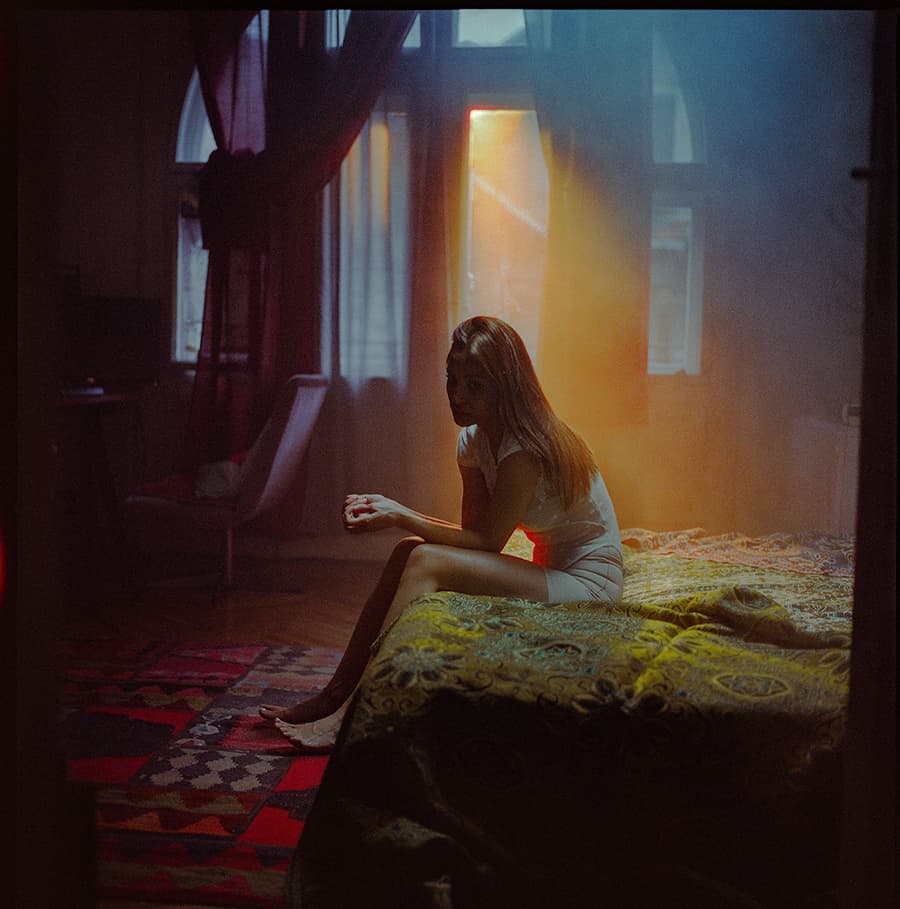
Costume plays an important role here to give us a clue to the story
Film = cinema
‘Using film is a big part of my photography. Film is the only medium that tells the audience immediately “this looks a bit like cinema” – it conveys a sense of theatre and movie magic. It’s in our nature to associate film with cinema. I tried to experiment with film and digital side-by-side, but with digital photography I felt I lost the emotion that film brings. It’s hard to describe what is missing – it’s really hard to describe it. There’s a magic that happens when I use film that doesn’t happen otherwise.
‘I mentioned to the colourist who colour-grades my work that I couldn’t describe the magic that happens when I use film. He suggested we look at the technical aspects of film, and showed me a histogram from a film scan that we compared to a digital histogram. The film scan had much more sophisticated rendering of highlight and shadow areas – the trace was smooth, rounded and balanced.
With a digital image you get to see everything, every detail, but it looks like chaos – our mind just can’t render that much information. Digital images are made from 1s and 0s, but it is the process of how film images are recorded on the stock that makes it look different.
Of course, the photographer’s approach is far more important than the medium he is using, and I know other photographers who create cinematic images using digital cameras. The medium is just a tool, and it has to suit the purpose.
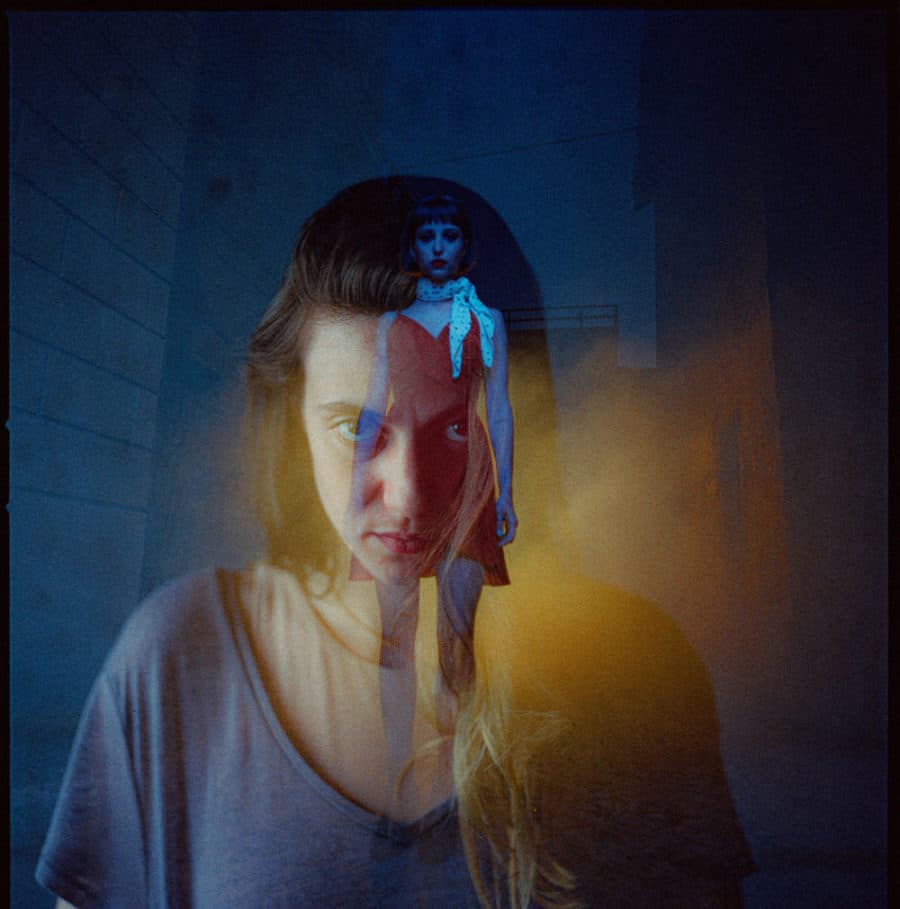
The double exposure effect suggests we can see what the girl is thinking
‘Average people can’t see what film stock you’ve used, or whether you have used film or digital cameras, but they can feel it. And that’s the catch. Normal people will know that they feel something. Digital cameras can show people what they would have seen, but film shows them what they would have felt.
There’s no doubt that you can shoot beautiful pictures with a digital sensor, but I think film gets you closer to the audience’s feelings and their heart. Human beings are analogue and we need to connect to analogue things for the sake of our body and soul.
‘We are familiar with old movies shot on film and we relate to that look – when we see it we know we are watching a movie. It’s the same in a way with vinyl records – the sound might not be as perfect as a digital music player, but we still like it and we make a connection with it. People find it easier to make a connection with these things.
That’s why there are labs opening up all over the world processing film. There are more movies being shot on 16mm and 35mm film now, and lots of music videos are recorded on film. When you see people shooting commercials with film stock you know the comeback is really serious! I’ve seen Lamborghini and Apple commercials shot on film.
‘Serbia isn’t part of the EU which makes film very expensive, so when I have meetings with producers they say “Come on man, no way” when I say I want to shoot on film. I ask them how much it costs to hire an Arri Alexa digital movie camera with some good lenses. Then we talk about how much film stock we can buy with that money. With that film stock we can make the same movie. There will be much less editing to do as we will shoot less, which is a good thing.
With film you have to think not twice but three or four times about each shot. Your mind is then forced to think more carefully about that shot and the chemistry begins to form the whole look of the movie. This is a great thing, because when you have expensive film stock you start to respect the value of production. You have to know what to shoot and what not to shoot, what shots you need and what shots you don’t need.’

Strong contrasting colours here make the subjects stand out
His pictures
Lazar’s latest project really caught my eye. The shots are in a blue factory of a girl dressed in red. They’re astonishingly good and filled with atmosphere. ‘These were shot on the set of a short movie I am making that will come out at the end of the year. It is a passion project. The movie will be a music video with an element of retro/futuristic science-fiction.
It will be about ten minutes long, but has taken six months to shoot as we have to wait for good light and good weather. The set is an old factory in Belgrade that was abandoned after the war. It’s huge inside and very clean – and it makes a crazy location. It has conference rooms and its own theatre – all in the brutalist Soviet style, which dictated the look of my photography. It’s one of the best projects I’ve done.
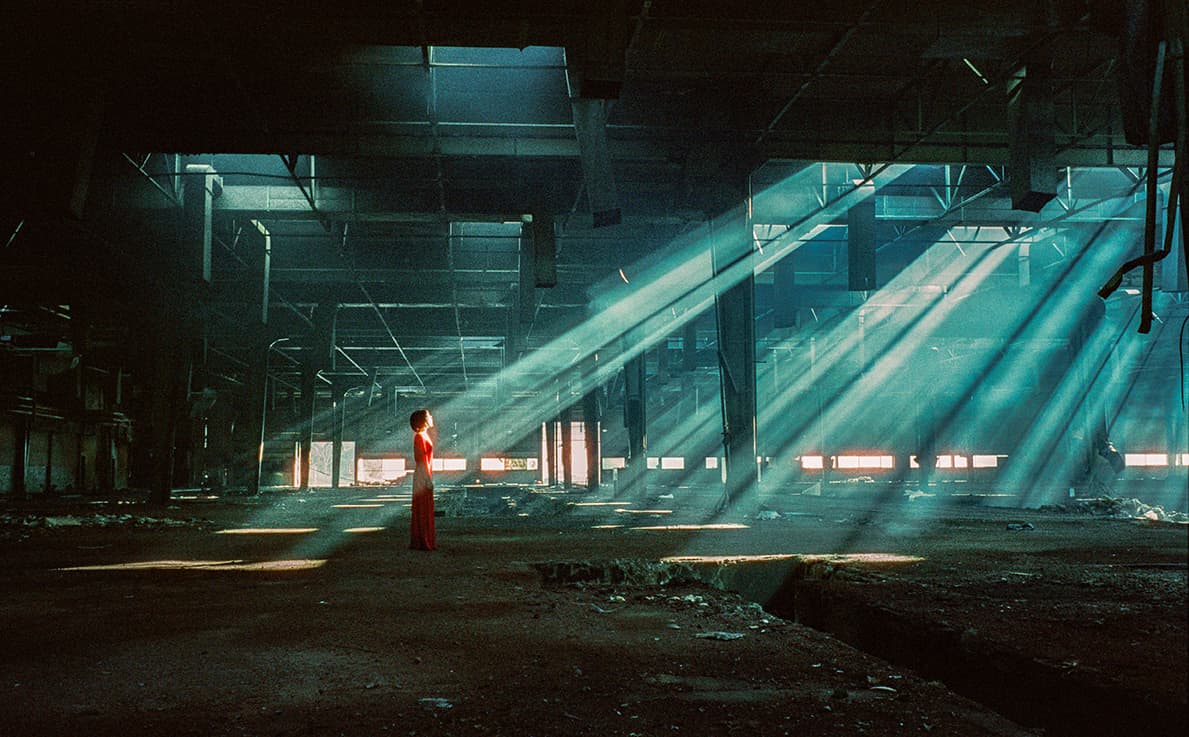
Lazar’s team waited two days for the morning sun to fall in the right place
‘We wanted to create a kind of spooky scene that represents the underworld and we lit it with cool colours – to create a sense of darkness but without it being dark. We dressed the actress in a red dress to make her stand out from the cold blue background. The red also marks her out as the hero. The colours tell us a story – she is in an unpleasant place but she’s on the side of good.
‘The lighting for the background is all natural, which is the way I like to work. These pictures were taken early in the morning in the autumn when the light is cold and diffused. We shot only in the morning and the evening, and we waited for two days for the position of the sun to create the rays through the ceiling windows. We used a mist machine inside the building to catch the rays, and the effect was completely mind-blowing. The sun was in the right position for about 20 minutes, so we had to be ready and work really quickly.’
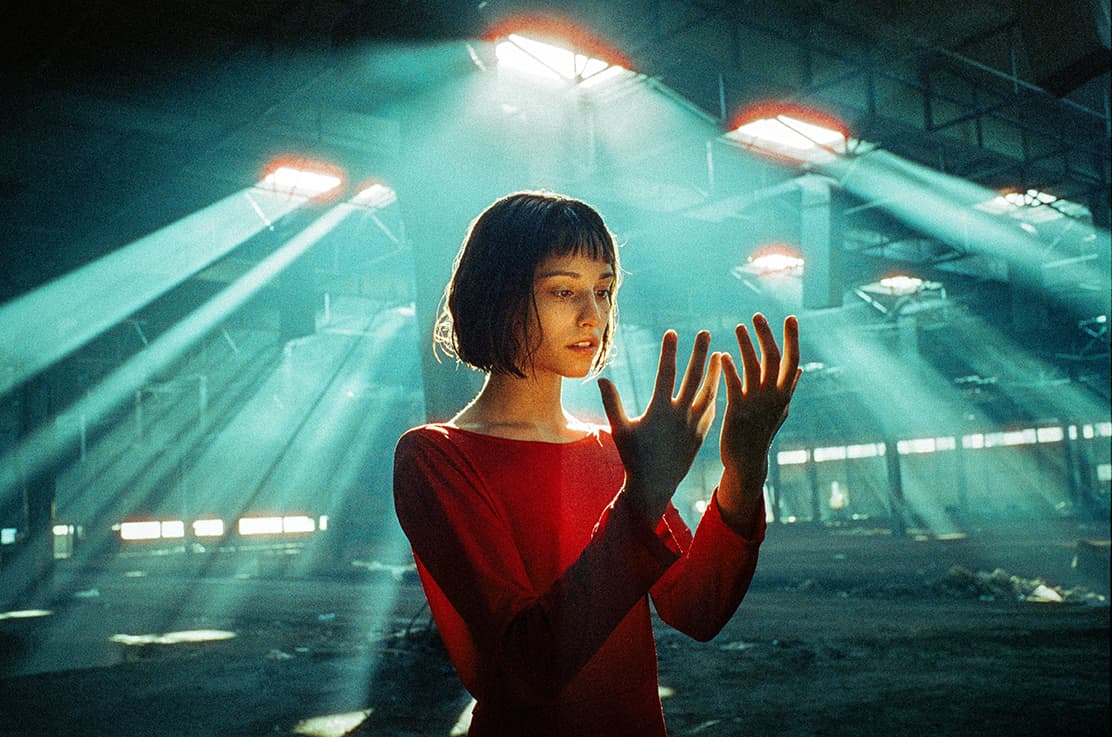
Lazar has similar themes in a lot of his work – depicting strong characters shot in a way to emphasise their strength. ‘The questions I ask myself are “How can I describe the feeling of that person with light and atmosphere? How can I show the audience what that person is feeling?” I do this with costumes, expressions, locations, atmosphere and body language.
As a photographer you must have some philosophy about what you want to say, but it is more important to think about what you are searching for and what you want to find. Whenever I shoot I always find something new.’
I’d never have thought to light someone outside in the daytime with a red light, but for one of Lazar’s pictures that’s exactly what he did. ‘I was always inspired by film noir when I was younger. Cinematographers in those days lit people outside with multiple lights as though they were in the studio, and in the studio they lit them naturally with bounced light.
Technically it’s hard to balance the exposure for the face with the background on a bright day, especially with a red light. So I made a tunnel of black cloth to shade the actress so the lights would show. I shot this on the Hasselblad with a slide film that has about 4EV of DR – just to make my life more difficult! But getting the exposure right means that the colour saturation is really strong. ‘Why is her face red? Because it makes the viewer think and instantly creates the thread of a story,’ Lazar explains.
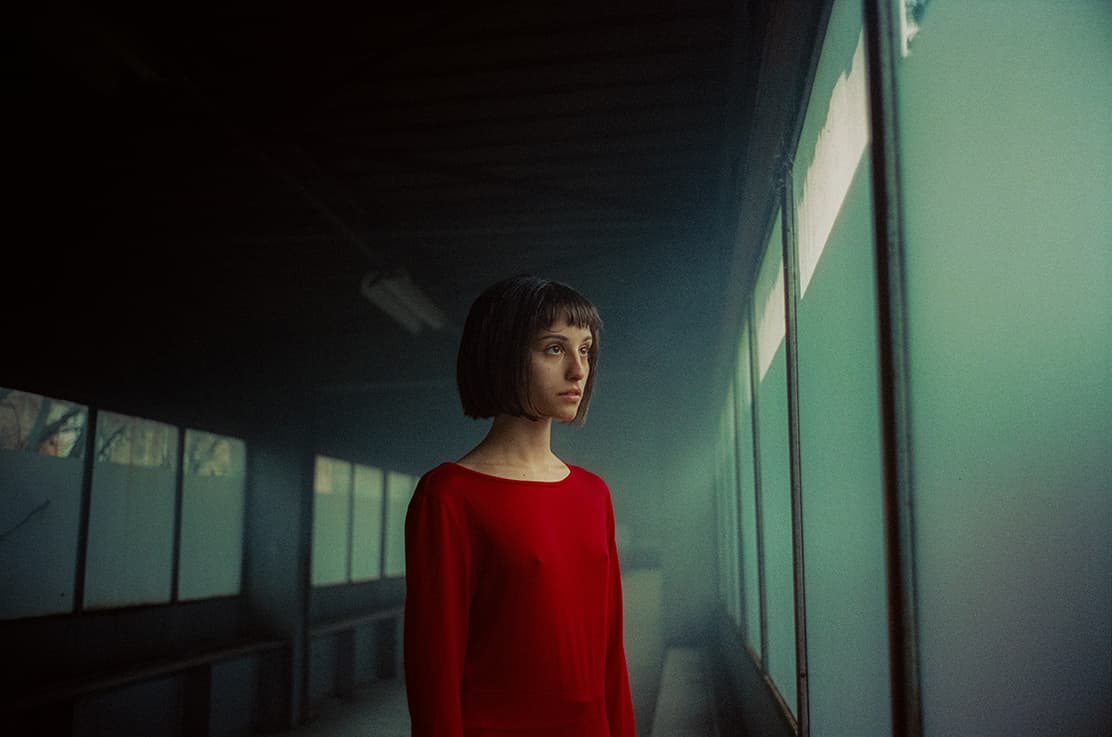
A dynamic contrast of warm and cool colours build the beginning of a story
Delving into kit
‘For stills I use a Leica M6 with a 35mm lens and a Hasselblad 500CM with the black 80mm lens. The 500CM is small for medium format, has good mechanics and a lovely viewfinder. I mostly use the M6 though. I’m a big fan of CineStill film. They’ve done a great job. Some people complain CineStill film has an anomaly with glowing reds, but I like that. It makes the film charming.
There are some guys in Germany who run a film company called Silbersalz35 too. They are spooling real Kodak Vision3 into 35mm film cassettes, and they develop it for you as well – the ECN-2 process is very different to regular C-41.
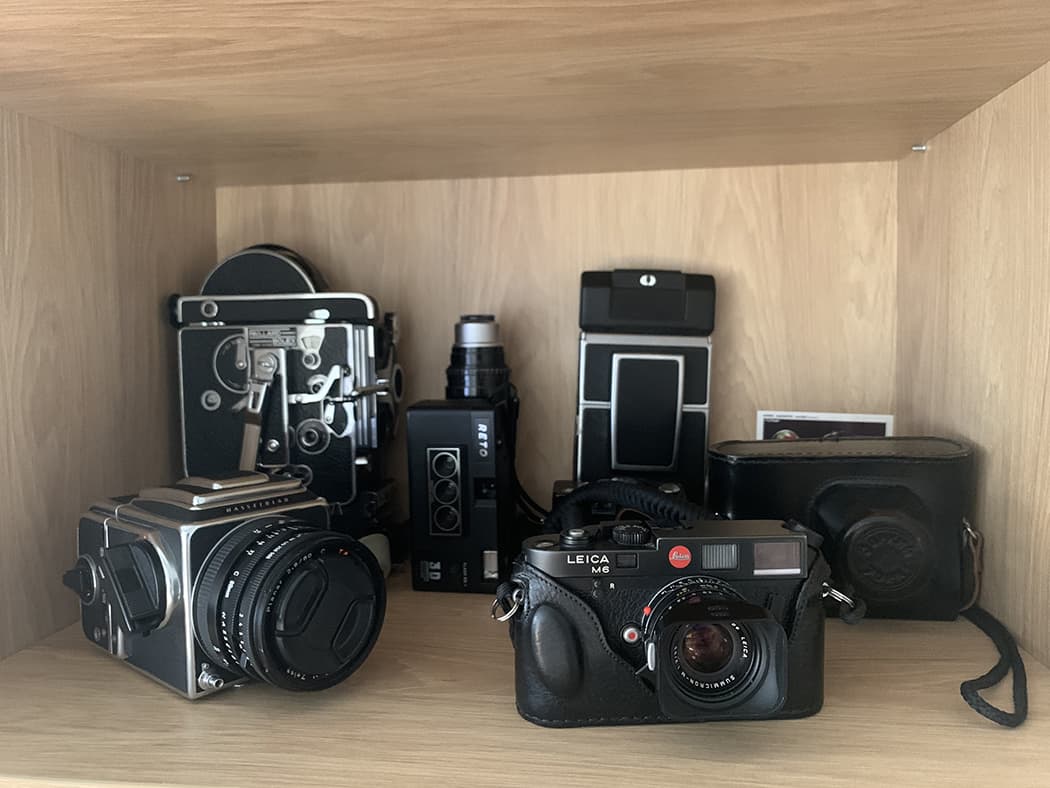
Lazar’s kit, including his Leica M6 and the Hasselblad 500C/M
‘I like to use LED panels to light my subjects, but I like to use tungsten light as well because a lot of film stock is designed to be used with tungsten lamps. The combination gives fantastic skin tones.
Sometimes I shoot with daylight film and light it with tungsten lights – it gives a great result. It feels completely different from the look you get with a digital sensor when you shoot with the “wrong” WB. On film it feels much more balanced.
‘Six or seven years ago I had four digital cameras, 5TB of files and zero good pictures. I couldn’t work out what was going wrong. I was shooting too much and shooting everything, so I decided I needed to change something. I sold my cameras and bought a Leica rangefinder.
When I was at university I shot a lot of film and considered myself a film photographer, but then digital came along and it was cheaper and I didn’t have the money for film.

Lighting his subject with a red light outside has created a really powerful image
‘When I switched back to film I had to think more about what I wanted to shoot, and it gave me more direction. I like film because you can’t see the result immediately. The wait is magic, as I spend time thinking about the shots I’ve taken and wondering if I should have done something different. It’s important to have that time, and to imagine the pictures. With digital photography everything happens very quickly and we don’t always have time to consider. We need to take time for our art.’
Tips for new film photographers: ‘Take your camera and go and shoot, experiment, try everything and break the rules. There are no rules in film photography, there are no bad cameras or bad lenses – only art. Think about your art and go and shoot. Be brave.’
Further reading
An introduction to medium format film photography





